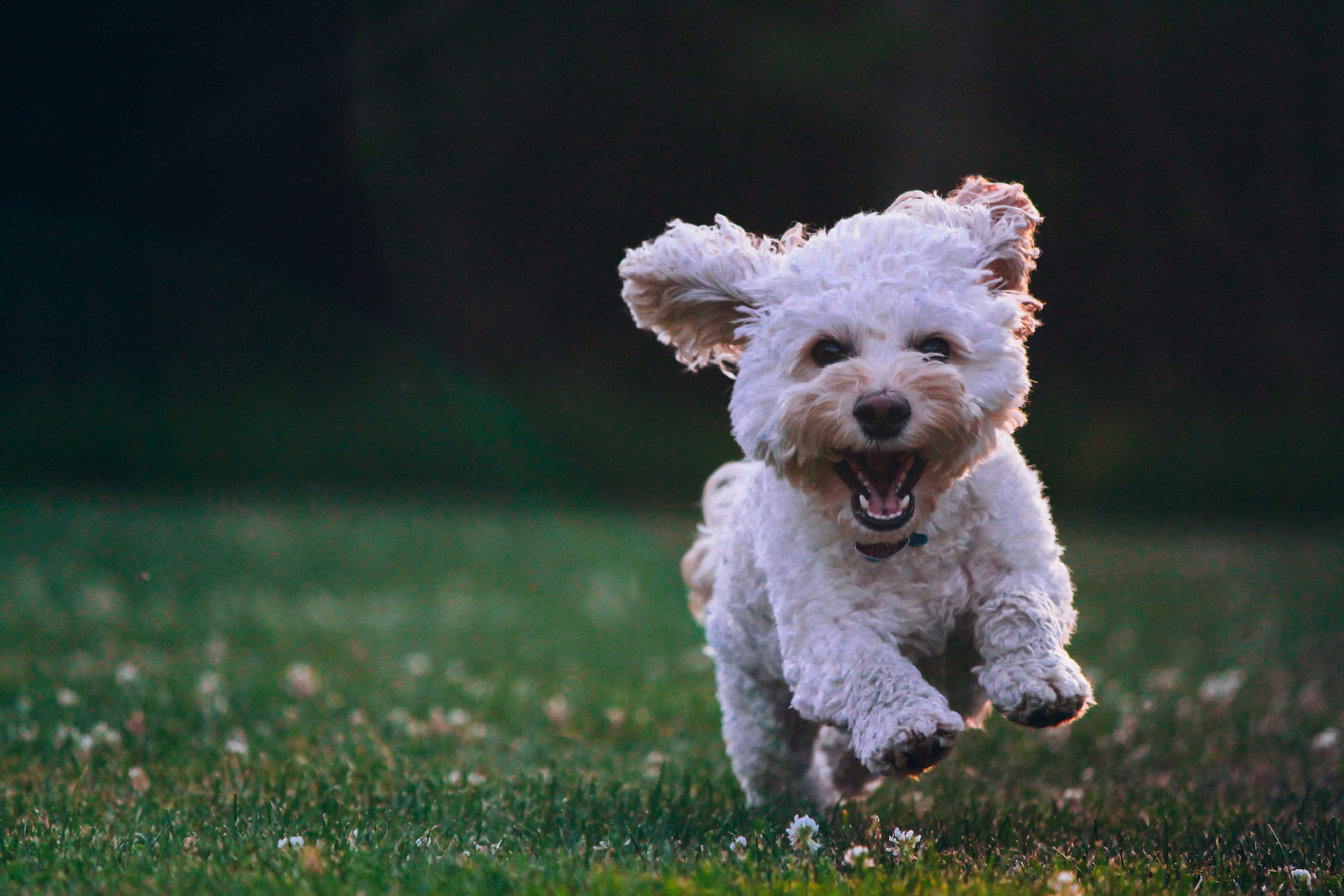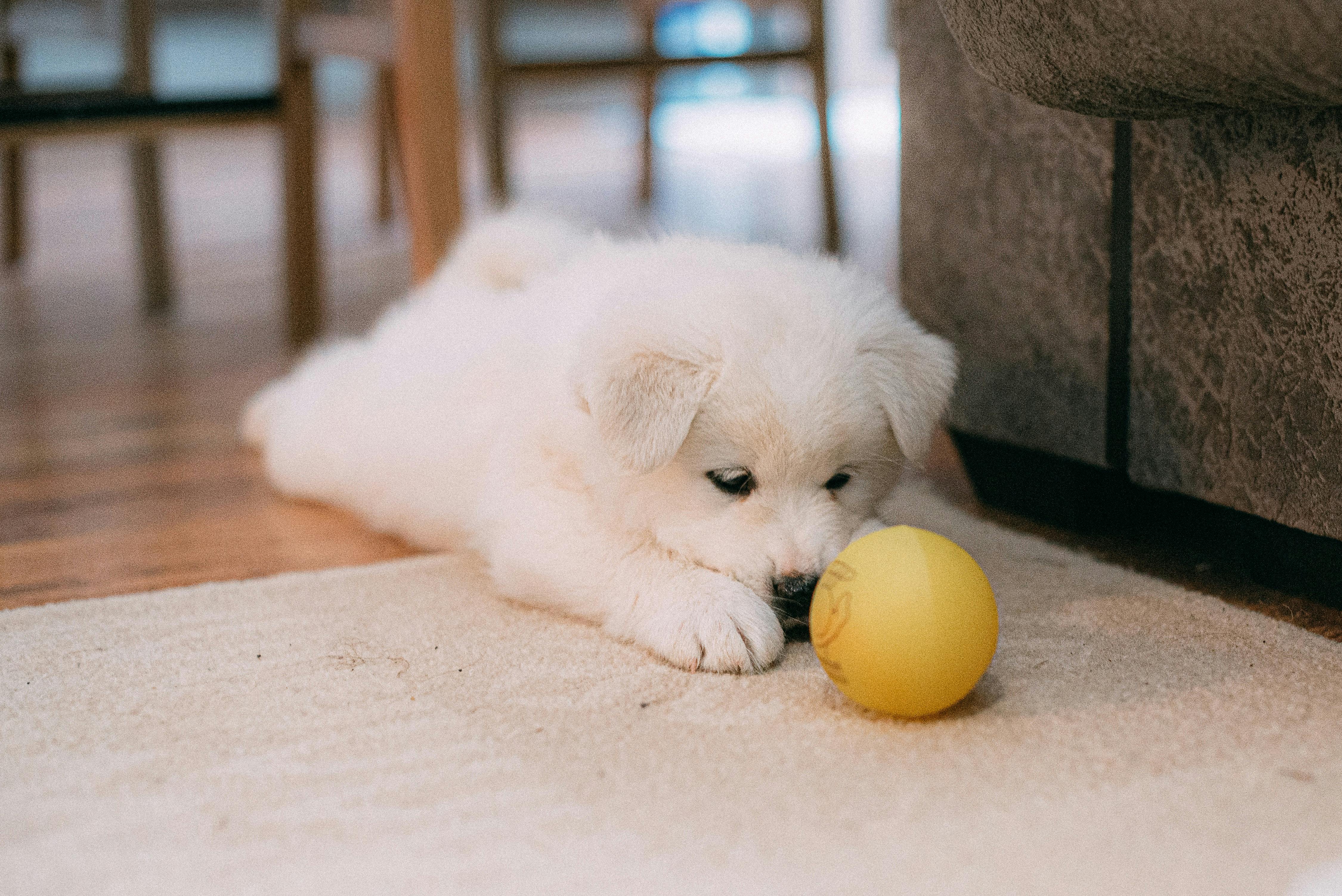
Unlock 10 Expert Puppy Training Tips!
Sign up with your email and receive a free video guide to transform your puppy into a well-behaved companion
When it comes to raising puppies, the internet is a treasure trove of information, advice, ridiculously adorable photos, and…myths.
So. Many. Myths.
Puppy myths can lead to confusion and misguided training practices that may be ineffective at best and harmful at worst.
So, let’s dive in and debunk ten common puppy myths to ensure your puppy grows into a happy, healthy, well-mannered dog.
Myth 1: Your Puppy is Trying to be Alpha
In case you live under a rock and don’t know, the alpha myth hypotheses that dogs naturally have a social hierarchy in which there’s an alpha dog who leads the “pack”—and that dogs are always striving to be the alpha of their human families. That’s why they jump, attempt to sleep on the bed, or pull on the leash.

This myth stems from outdated studies on captive wolf behavior, which have since been debunked.
I know, I know. The idea of the alpha dog permeates all aspects of our culture, so it can be difficult to let go of. That’s likely why it’s been debunked for decades and, yet, here we are.
Modern dog behaviorists and researchers have shown time and again that the dynamics within dog-human relationships (and dog-dog relationships for that matter) are not about being alpha.
Puppies engage in behaviors like excessive leash pulling or chewing on your shoes primarily because they’re excited, seeking attention, or haven’t yet learned appropriate behaviors, not because they’re trying to establish a pecking order.
So, next time you feel like your dog is trying to assert their dominance, take a moment and try to evaluate their behavior from a different perspective.
Viewing these actions through a lens of dominance can lead you to try and assert your dominance back, which may harm the relationship between you and your puppy and lead to feelings of anxiety in your dog. Anxious dogs are more likely to engage in aggressive behaviors.
Additionally, it’s just not going to work well since you aren’t addressing the true root cause of undesirable behaviors.
Instead, you should train your dog using positive reinforcement techniques, which focuses on reinforcing desired behaviors. Positive reinforcement is based on the latest dog training science, is effective, and does not pose a risk of increasing anxious or aggressive behaviors.
Myth 2: Your Puppy is Being Spiteful
So many of my friends, neighbors, family members, and clients have told me that their dog did some undesirable behavior out of spite.
Spot chewed up a pair of slippers because his humans left him alone.
Luna had an accident in the house because she was scolded for barking.
Shadow ignored a command because his human didn’t share a slice of pizza with him.
But Spot likely chewed those shoes because it was available, smelled like his human, and felt good (or because of separation anxiety).
And Luna likely peed because of simple bladder pressure without the access to an appropriate elimination area.
And Shadow ignored a command because it wasn’t trained properly or because he was too distracted.
When a puppy misbehaves, it’s not an act of vindictiveness but rather a lack of understanding, a response to stress, or simply because they’re being a puppy.
Puppies do not have the cognitive capacity to plan actions based on spite; they do what we all wish we could and live very much in the moment.
Like I said above with the alpha myth, it’s key to understand the true motivations behind your puppy’s behavior. If you train them based on the assumption that they’re spiteful, your training sessions likely won’t go very far—and you’ll be far more frustrated than you need to be.
Instead, try to understand your puppy’s true motivations.
Myth 3: Your Puppy Knows Better
Another misconception is that puppies frequently “know better” but choose to ignore rules anyway. Because, you know, puppies are little rebels (cue the guitar riff).
In reality, when puppies do not respond to a command you believe they should know, break a rule, or otherwise “act out” there’s a reason for it.
Are you starting to sense a pattern here? There’s always a reason for a dog’s behavior and it’s not usually a complicated socio-emotional reason as you might find in relationships between humans.

One reason could be a lack of consistency around house rules. Puppies, much like children, thrive on consistent guidance and clear boundaries. When rules change, it confuses them, making it hard to understand what’s expected. A puppy that receives mixed signals from different family members, or at different times of day, will struggle to follow any rules at all.
Puppies also have innate needs that must be fulfilled due to their age or breed. A lack of appropriate opportunities to fulfill such needs—like chewing, problem solving, and exercise—can lead your puppy to seek them out on their own. A puppy that chews on furniture might simply be teething without access to enough appropriate chews. A puppy who hasn’t been mentally enriched might engage in counter surfing. A puppy that hasn’t gotten enough sleep may be more mouthy.
Boredom and curiosity are also powerful motivators for puppies. Puppies tend to be curious little creatures, which drives them to sniff, taste, and interact with their environment. That can be problematic when their environment involves electrical cords, beloved children’s toys, or tree bark that can cause choking when they painstakingly try and chew every tree they come across (speaking from experience here).
Finally, distractions can derail a puppy’s focus, making it seem like they’re ignoring commands on purpose. In reality, they are just overwhelmed or overly interested in something else. This is normal. This can be true for humans too.
You can probably sing Twinkle Twinkle Little Star alone in your shower perfectly. Now try singing it while driving on a winding mountain pass while the radio blasts Taylor Swift. Not as easy, huh?
(When training puppies, it’s best to start in distraction-free environments and then systematically introduce distractions in a controlled way. This will teach your dog to listen in a variety of circumstances.)
As always, the key here is to attempt to understand your puppy’s true underlying emotions for their behaviors and address that.
When you know why your puppy is doing something you don't like—instead of thinking they’re trying to be alpha, being spiteful, or otherwise just being annoying for the sake of it—it can help you be a little less frustrated with them.
Myth 4: The More Experiences, The Better When it Comes to Puppy Socialization
It’s easy to believe that exposing your puppy to as many new experiences, animals, and people as possible is the key to a well-adjusted adult dog. But this approach overlooks the quality and pace of these interactions, which is equally as important as variety.
While socialization is essential for developing a confident and sociable dog, overwhelming a puppy with too many new experiences too quickly can have the opposite effect.
Puppies, especially during their critical socialization window (typically between 3 and 14 weeks of age), are highly impressionable. Negative experiences or overly stressful situations can lead to long-term fears and anxieties.
The goal of socialization should be to introduce new experiences in a controlled, positive, and gradual manner.
Think quality over quantity. Each new experience should allow the puppy to explore at their own pace.
For instance, a well-managed playdate with a calm, friendly dog can be far more beneficial than a hectic dog park visit. Similarly, a quiet gathering with a few guests can help more with socialization than a loud, crowded event.
Myth 5: Your Puppy Will Be Fully Trained by the Age of Six Months or One Year
Expecting a puppy to be fully trained by six months, or even one year, is unrealistic. While many puppies can learn basic cues and house training at a young age, training is a lifelong process.
Dogs continue to learn and adapt well into adulthood, and consistent, positive reinforcement training throughout their life is key to good behavior.
Yes, you heard it here first, an old dog can and should learn new tricks.
Some behaviors take months, if not years, of training to master. A bombproof recall will likely take you at least one year to train to fluency.
Moreover, socialization, potty training, grooming desensitization, and bonding with your puppy should take precedence over training specific behaviors such as sit or stay. You can teach your dog new cues over their entire lifetime whereas the socialization window is short.
Myth 6: Your Puppy Will Get Along with Everyone

If you close your eyes and think of the perfect dog you likely see a friendly pup who is highly sociable and unfazed by strangers, whether of the human or dog variety.
It’s what many people imagine when they bring their puppy home.
But the truth is some dogs are more sociable than others.
Just like people, puppies have their own personalities, preferences, and limits when it comes to social interactions.
Some dogs are naturally outgoing and seem to revel in meeting new friends, whether they’re humans or other animals. Others may be more reserved or cautious, particularly in new or crowded environments.
Expecting all puppies to uniformly enjoy and seek out all social interactions can lead to stress and anxiety for dogs that are more introverted or shy.
It’s better to accept your unique puppy for who they are.
Myth 7: It is Normal for Puppies to Be Nervous Around People or Dogs
As aforementioned, it’s normal for some puppies to be shy or reserved, but excessive anxiety around humans and other dogs is not normal. Said another way—occasional anxiety is expected, but if it becomes excessive, consistent, or escalates, it may indicate a deeper issue.
If your puppy reacts by barking, lunging at people or dogs, or exhibits signs of anxiety like peeing, trembling, or avoiding situations that trigger their fear, it’s time to consult a qualified trainer or behaviorist. Addressing these issues early can make a significant difference in changing your dog’s response to what frightens them.
Myth 8: It is Normal for Puppies to Be Nervous When Left Alone
While it’s understandable that puppies might be initially bummed about being alone, intense anxiety, panic, or distress when separated from their owners isn’t a normal or healthy part of puppy development. In fact, puppies who display intense panic when home alone may have separation anxiety.

Signs of separation anxiety include excessive barking or howling, destructive chewing, attempts to escape, extreme restlessness, or self-mutilation. These behaviors are not just a puppy being a puppy; they indicate the puppy is experiencing significant distress.
Early intervention is key to addressing and managing separation anxiety. You can also do separation anxiety prevention work by making your dog’s confinement area and alone time fun with food-storage toys, using a confinement area several time a day for short periods of time without actually leaving, and avoiding scolding your puppy when you arrive home, even if puppy did something “naughty” while you were away.
Note that separation anxiety can be a genetic disorder and cannot always be prevented.
Myth 9: A Puppy Must be Fully Vaccinated To Be Socialized
While you obviously want to protect your puppy from diseases, keeping them from socialization opportunities until they’re fully vaccinated can hinder their development. Exposure to various stimuli, including people, other animals, and environments, is essential for a puppy to grow into a well-adjusted adult dog. In fact, the American Society of Veterinary Behaviorists suggests taking your puppy to a socialization class starting as early as seven weeks old.
Consult with your vet about safe ways to socialize your puppy before completing their vaccine series.
Myth 10: Puppies Come Pre-Programmed
One of the most persistent myths in puppy ownership is the belief that puppies come pre-programmed with the knowledge of how to behave according to human expectations.
People assume that their puppies will instinctively know not to jump on guests, understand commands like “sit” or “stay,” or naturally respect the boundaries of the home.
This misconception can lead to frustration for both the puppy and the owner when reality doesn’t meet these expectations.
Expecting a puppy to automatically know how to behave in a human-centric world is akin to expecting a toddler to know how to read without being taught.
Conclusion
I don’t know about you, but I enjoy my relaxation time. There’s nothing better than kicking back with an iced coffee and a good book. So, when it comes to dog training, I want to train smarter, not harder.
To do that, it’s important to train effectively by addressing the root causes of behavior.
If you spend your time training based on myths, you’ll likely end up frustrated, your puppy will be confused, and you won’t have that precious reading time (or video game time, or hiking time, or chilling-at-the-winery time…).
I hope this myth busting post helps you do just that.
Happy Training!









